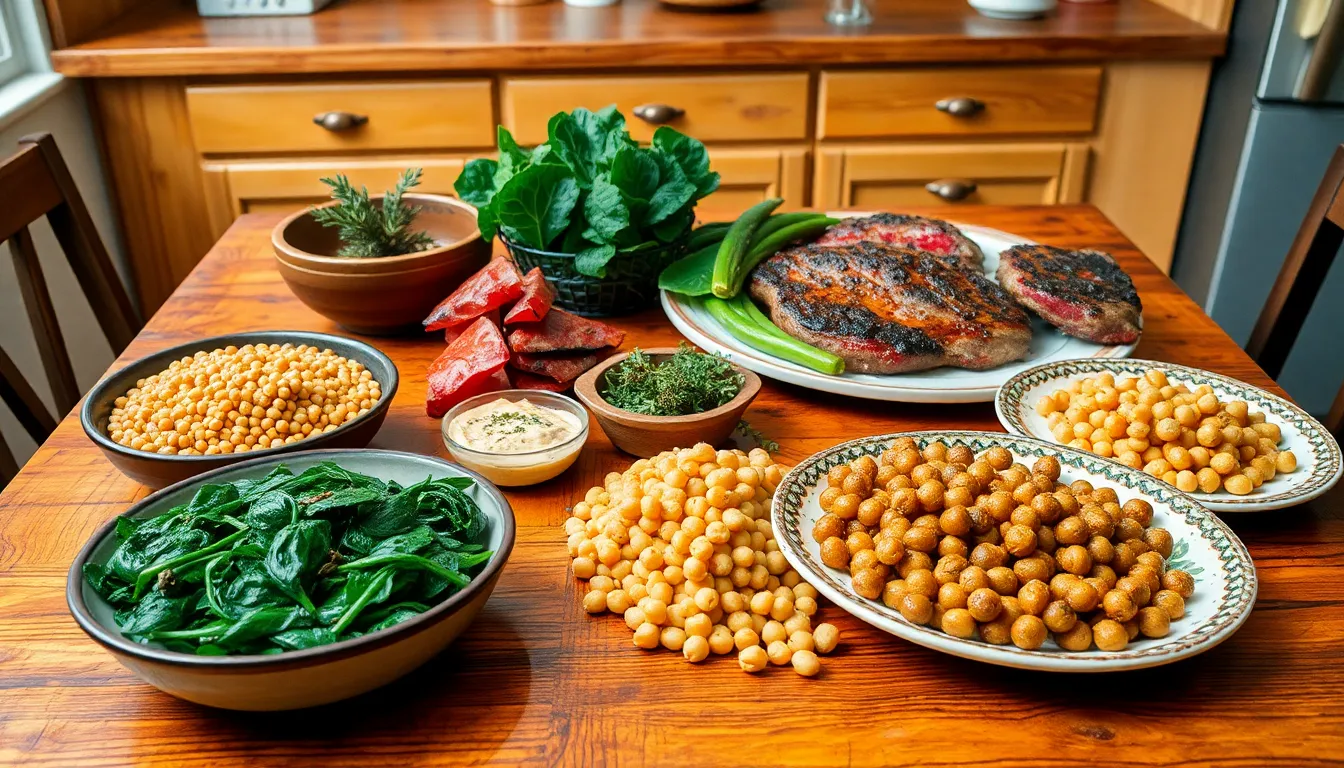Feeling a little sluggish? It might be time to give your iron levels a boost. Iron is like the superhero of nutrients, swooping in to save the day by keeping energy levels high and warding off fatigue. But not all heroes wear capes; some come in the form of delicious foods that pack a serious punch of iron.
From leafy greens to savory meats, iron-rich foods can transform your meals from mundane to mighty. Imagine biting into a juicy steak or tossing a handful of spinach into your smoothie, all while knowing you’re fueling your body with what it needs. So, let’s dive into the tasty world of iron-rich foods and discover how they can turn your plate into a powerhouse of health. Who knew eating well could be this exciting?
Table of Contents
ToggleWhat Are Iron-Rich Foods?
Iron-rich foods play a vital role in maintaining optimal health. These foods help combat fatigue and support energy levels. Common sources of iron include red meats, poultry, and fish. Leafy greens such as spinach and kale also provide significant iron content. Legumes, including lentils, chickpeas, and beans, serve as excellent plant-based iron options.
In addition, fortified cereals and whole grains contribute to daily iron intake. Nuts and seeds, such as pumpkin seeds and cashews, offer a crunchy way to add iron to meals. Consuming vitamin C alongside iron-rich foods enhances iron absorption. Citrus fruits, bell peppers, and strawberries prove effective in this regard.
A well-balanced diet incorporating these foods supports not just energy levels, but also overall health. To achieve optimal iron intake, diversify meal options by including a combination of animal and plant sources. Being aware of iron-rich foods encourages better dietary choices and helps prevent deficiency.
Benefits of Iron-Rich Foods

Iron-rich foods support overall health and well-being, offering multiple benefits. These foods play a crucial role in nourishing the body and preventing deficiencies.
Importance of Iron in Health
Iron is essential for producing hemoglobin, a protein in red blood cells that carries oxygen throughout the body. It contributes to the proper functioning of muscles and the immune system. A diet lacking in iron can lead to anemia, characterized by fatigue and weakness. Women, children, and individuals with specific health conditions benefit significantly from adequate iron intake. Incorporating a variety of iron sources helps maintain optimal health and supports bodily functions.
Impact on Energy Levels
Energy levels depend largely on sufficient iron intake. Iron facilitates oxygen delivery to cells, promoting physical and mental vitality. Low iron levels often result in feelings of fatigue and lethargy. Consuming iron-rich foods helps combat these issues, enhancing stamina and performance in everyday activities. Including sources like red meats, leafy greens, and legumes boosts overall energy levels effectively. Regular intake ensures the body’s energy production stays at its peak.
Types of Iron-Rich Foods
Iron-rich foods come in two main categories: animal-based and plant-based sources. Both types provide essential nutrients that support overall health.
Animal-Based Sources
Animal-based sources of iron contain heme iron, which the body absorbs more efficiently. Red meats like beef and lamb offer high iron content, with ground beef containing about 2.7 mg of iron per 3 oz. Poultry such as chicken and turkey also contributes, with approximately 1.3 mg per 3 oz. Fish, particularly tuna and salmon, provides about 1 mg per 3 oz. Additionally, organ meats like liver are exceptionally rich in iron, containing over 6 mg per 3 oz. Including these foods in meals can significantly enhance iron intake.
Plant-Based Sources
Plant-based sources primarily provide non-heme iron, which has a lower absorption rate. Leafy greens like spinach and kale offer substantial amounts, with cooked spinach containing about 6.4 mg per cup. Legumes, such as lentils and chickpeas, also serve as excellent sources, with cooked lentils providing about 3.3 mg per cup. Whole grains, including quinoa and fortified cereals, enhance variety and can contribute 1.2 mg to 18 mg per serving, depending on the product. Nuts and seeds like pumpkin seeds add another layer of nutrition, with about 2.5 mg per ounce. Combining these foods with vitamin C-rich items enhances iron absorption, making them even more beneficial.
How to Incorporate Iron-Rich Foods into Your Diet
Incorporating iron-rich foods into daily meals ensures optimal energy levels and health benefits. Explore these strategies to effectively include these foods in a nutritious diet.
Meal Planning Tips
Plan meals around iron-rich foods to enhance intake. Choose a mix of animal and plant sources, such as red meat, poultry, lentils, and spinach. Create weekly menus featuring new iron-rich recipes to maintain variety. Incorporate fortified cereals at breakfast for a nutrient boost. Pair foods high in vitamin C, like citrus fruits and bell peppers, with meals to enhance iron absorption. Snack on nuts and seeds during the day to maintain energy levels and increase iron content.
Cooking Methods to Maximize Iron Absorption
Utilize cooking methods that enhance iron absorption. Cooking in cast iron cookware increases the iron content of food, particularly when preparing acidic dishes. Steaming vegetables preserves nutrients while maintaining iron levels. Avoid drinking tea or coffee during meals, as they can inhibit iron absorption. Instead, opt for herbal teas or water. Eating raw vegetables alongside cooked options introduces additional nutrients, further promoting overall health. Apply these methods to ensure the body effectively absorbs iron from meals.
Incorporating iron-rich foods into daily meals is essential for maintaining energy and overall health. By diversifying dietary options with both animal and plant sources, individuals can enhance their iron intake effectively. Utilizing cooking methods that promote absorption and pairing iron-rich foods with vitamin C can maximize benefits. Regularly enjoying these foods not only helps prevent deficiencies but also supports physical and mental vitality. Embracing these practices can lead to a more nutritious and enjoyable diet, empowering individuals to thrive in their daily lives.





